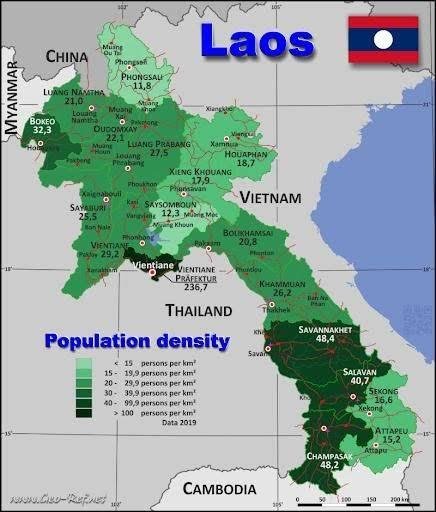No products in the cart.
Explore the broader aspects of Laos including economy, governance, culture, environment, and ASEAN integration. A comprehensive overview for businesses, travelers, and researchers.

Laos is often described as one of Southeast Asia’s hidden gems. Landlocked but strategically positioned between Thailand, Vietnam, China, Myanmar, and Cambodia, the country plays a significant role in the Mekong sub-region. While much attention is given to Laos’ economic and investment environment, broader topics such as governance, culture, environmental sustainability, and international relations are equally important in shaping the nation’s identity and development path.
This article provides an expansive look at Laos, covering its governance, economy, culture, environmental policies, and regional integration efforts. By exploring these broader topics, businesses, travelers, and policymakers can gain a deeper understanding of the opportunities and challenges in the Lao People’s Democratic Republic (PDR).
Economic Development and Diversification
Laos’ economy has traditionally relied on hydropower, agriculture, and mining. However, recent efforts have focused on diversification:
Hydropower & Energy Exports: Laos continues to expand as the “Battery of Southeast Asia,” exporting electricity to neighbors.
Tourism & Hospitality: Cultural tourism in Luang Prabang, ecotourism in Nam Et-Phou Louey National Park, and adventure tourism in Vang Vieng are central to diversification.
Manufacturing & SEZs: Special Economic Zones are attracting light manufacturing and logistics investments.
Digital Economy: FinTech, e-commerce, and digital governance platforms are opening new growth opportunities.
Despite high public debt and inflation challenges, economic reforms and ASEAN integration promise long-term growth potential.
Governance and Public Policy
Laos’ governance structure is centralized under the Lao People’s Revolutionary Party (LPRP), but public policy reforms are gradually empowering provinces and local authorities.
Decentralization (“Sam Sang” Policy): Districts act as development units, provinces handle strategic planning, and villages focus on local implementation.
Public Policy Priorities: Focus areas include poverty reduction, education, healthcare, and sustainable resource management.
Transparency & Reform: Anti-corruption efforts and e-government initiatives aim to improve accountability and efficiency.
While institutional capacity challenges remain, public policy trends indicate a gradual shift toward more inclusive and transparent governance.
Society and Culture
Laos is home to more than 49 officially recognized ethnic groups, each contributing to the nation’s cultural richness.
Religion: Buddhism is the dominant faith, influencing daily life, festivals, and national identity.
Festivals: The Lao New Year (Pi Mai), Boun That Luang, and boat racing festivals reflect the country’s traditions.
Language & Identity: Lao is the official language, but many ethnic dialects are spoken across provinces.
Cultural Etiquette: Respect for elders, modest dress, and Buddhist practices shape social norms.
This cultural diversity creates opportunities for tourism, education exchange, and cultural preservation projects.
Environmental Policies and Sustainability
As a biodiverse country, Laos faces both opportunities and challenges in environmental management.
Forestry & Biodiversity: National protected areas safeguard wildlife such as tigers, gibbons, and elephants.
Climate Change: Laos is vulnerable to flooding, droughts, and shifts in rainfall patterns.
Sustainable Development: The government promotes eco-tourism, organic agriculture, and renewable energy.
Green Growth Strategy: Policies aim to balance hydropower expansion with ecological conservation.
Environmental stewardship is vital for tourism and long-term economic resilience.
Regional and International Integration
Laos’ land-linked geography is central to its development strategy.
ASEAN Membership: Provides access to regional markets and harmonized regulations.
China’s Belt and Road Initiative: Major projects such as the Laos-China Railway improve trade connectivity.
Mekong Cooperation: Laos participates in Mekong River initiatives for water resource management and trade.
Global Partnerships: Engagement with the World Trade Organization (WTO) and development agencies strengthens reforms.
These integrations elevate Laos’ role from being a landlocked nation to a land-linked hub for regional trade and diplomacy.
Challenges Facing Laos
Despite progress, Laos faces several structural challenges:
Public Debt: High levels of debt require fiscal discipline and debt restructuring.
Capacity Gaps: Limited human resources hinder governance and institutional efficiency.
Rural Inequality: Many rural communities lack access to healthcare, education, and digital infrastructure.
Overdependence: Heavy reliance on energy and resource exports makes Laos vulnerable to external shocks.
These challenges highlight the need for reforms, inclusive policies, and sustainable growth strategies.
Future Outlook
The future of Laos will be shaped by its ability to embrace reforms while leveraging its cultural and geographic advantages.
Economic Growth: Stronger diversification into tourism, manufacturing, and digital sectors.
Social Development: Greater investments in healthcare, education, and gender equality.
Environmental Protection: Expanding eco-tourism and renewable energy projects.
Global Role: Closer integration with ASEAN and international partners will increase Laos’ influence in regional decision-making.
If reforms are implemented effectively, Laos will continue to emerge as a competitive and sustainable economy in Southeast Asia.
Conclusion
Laos is more than an investment destination—it is a nation shaped by its culture, traditions, and strategic location. By strengthening its governance systems, embracing sustainable policies, and deepening international cooperation, Laos is building a foundation for balanced growth.
For businesses, travelers, and policymakers, understanding the broader topics related to Laos is essential for making informed decisions and fostering long-term partnerships.
About CITS Laos
CITS Laos provides expert advisory services across multiple domains, including business compliance, public policy navigation, cultural engagement, and sustainable investment planning. Whether supporting foreign investors, NGOs, or tourism operators, our team ensures that clients understand the broader economic, social, and cultural context of Laos.